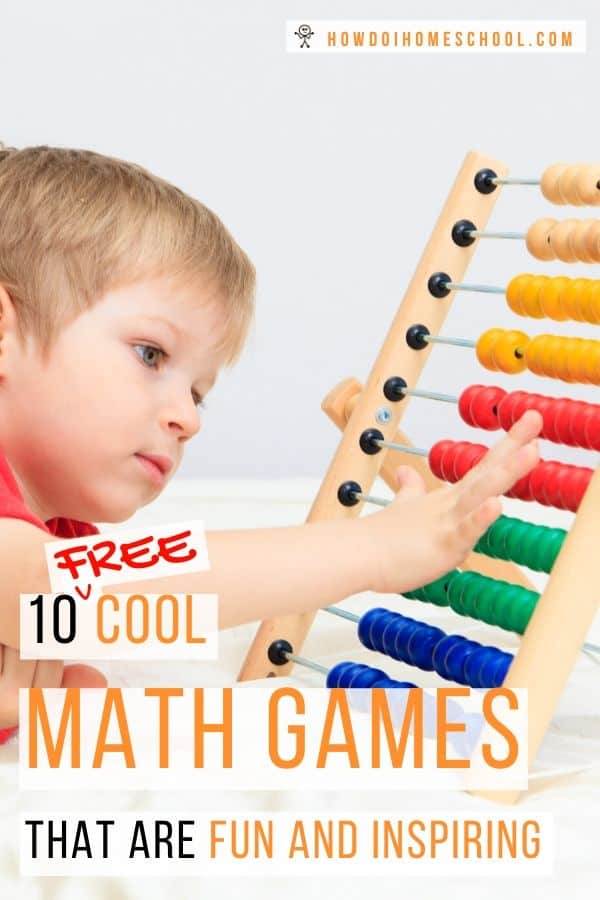10 Cool Math Games that are Fun, Inspiring, and Offline!
Was learning math a drag for you in school? Would it have been easier if you didn’t have to rote learn your multiplication tables? Would some fun math games have helped you stop dragging your feet? This article is designed to give you some cool math games that you can do with your children at home to help them learn their arithmetic in an exciting way.
Cool Math Games on This Page
The math games on this page consist of a few different types; outdoor games, board games, and indoor games. They are activities that kindergarten, middle school, and high school-aged students will enjoy. I’ve made several up myself and modified a few from other sources. Most are free, except a few board games that I feel deserve a mention. Here is the selection that’s on this page:
- Math Bingo
- Suduko
- Math Solitaire
- Quickest Wins
- Math Tip
- Odds or Evens?
- Fun Finska
- Cool Math Scavenger Hunt
- Proof!
- Math Dice
Find out how you can use these games in your school or homeschool below.

HDIH is a participant in the Amazon Services LLC Associates Program, an affiliate advertising program designed to provide a means for sites to earn advertising fees by advertising and linking to amazon.com.
1. Math Bingo
I discovered this game when talking to a lovely homeschool mom. She said her children loved math. She believed this was because much of the math they taught was taught using fun math games. Their favourite game was Bingo – with a cool math twist.
You set up the game by giving your children a piece of paper with a set of numbers on it which corresponds to a set of cards (which the teacher holds) that have the sums that equal the answer on the paper the student has. The educator then calls out the sum and the student has to work out the answer and cross off the answer. When their paper is completed, the first to do it calls out, ‘Bingo’ and wins!
You can make the tokens and board pieces yourself or save yourself a lot of time and get one for addition and subtraction here and one for multiplication and division here. The first is for ages 5+; the second is for ages 9-13. They both accommodate 3 to 36 players so you can play it with many children in a classroom if you’re a teacher.
2. Sudoku
Bet you didn’t know Suduko could be classed as a fun math game! In fact, it is a brilliant way for emergent mathematicians to enjoy learning their numbers while playing a fun game.
You can play this game for free by printing some free sudoku puzzles.
Or you can simply buy a sudoku book (this kids version is a great and educational present idea) to give to your students. Most of them will love owning it and take to the game immediately.
3. Math Solitaire
To play this cool math game, you need to have an ordinary pack of playing cards. Place two cards in the middle of the table and give your students 3 cards which they can pick up when the educator says, ‘Go.’
Use the cards to add, subtract, multiply, or divide so the number that you get equals the number in the middle. If students can’t do this with the cards they’re holding, they can each pick up another card until one of them can do this. The first to do this wins the round! Play 5 rounds and the person who has the most round wins then wins the whole game.
4. Math Tip
If you don’t want to be stuck indoors the whole day, check out this active fun math game I like to call, ‘Math Tip’. The aim of this game is to learn addition and subtraction while getting outdoors and doing a little exercise together! Hopefully, nerds and jocks alike will enjoy this one!
In Math Tip, children have numbers attached to their body (wrist, back, or chest) and you have 10 chairs with the numbers 1-10 emblazoned on them.
The teacher calls, ‘Add’ or ‘Subtract’, and then the students need to find other students with the appropriate number before going together to the correctly numbered station.
For example, if a teacher says subtract, a student with the number 9 on their wrist finds another student with a 6 and then runs to the appropriate station, which would be a 3. If the teacher says to add, a student with a 2 might find a student with a 3 and then run to the station marked 5.
The remainder of the students can help the other students by calling out so the most amount of students can get to a station. This way it is collaborative rather than competitive.
5. Quickest Wins
This game is a two-player game. Students can play it with their teachers or parents if they’re homeschooled. The aim of the game is to sharpen your math skills and make you super quick at coming up with correct answers.
Pick two numbers out of your deck of cards. You have to quickly add the numbers together, subtract them, multiply them, and then divide them. Quickest person to do this wins the round. Have five rounds and see who wins the game.
As students get older, they can choose larger numbers to add, subtract, multiply, and divide.

6. Odds or Evens?
Odds or Evens is another cool math game that allows children to get out and about.
The aim of the game is to teach students odd and even numbers, so it’s probably a good math game for Kindergarten or Year 1.
Teachers call out a number. If the number is odd, students have to hop up and down on one foot. If the number is even, they have to crouch down on the ground with their head between their legs. The students who get it right stay in until there is only one person left who wins.
7. Fun Finska
Fun Finska (or Molkky) is a fun math game for Kindergarten or primary school-aged children. It teaches them simple addition as they need to add the number they’re up to in order to win the game.
To win the game, students need to knock over a set of blocks with numbers on them. They add the numbers up as they knock the pins down. If they get to 50 they win. If they go past this number, they have to go back to 25 and start from midway. This helps them calculate simple sums in their head.
Grab a copy of this game here.
8. Cool Math Scavenger Hunt
I found the following fun math game from Samantha’s website, Learn in Color, and thought it was a wonderful idea!
Using the list of objects on the paper at this link (which you can buy), sit your children down with a good newspaper or magazine and get them to search for the appropriate corresponding lines or math subjects.
9. Proof
Proof is a cool math game that suits Kindergarten to high school level students. Suitable for a homeschool, school, or family night in, this board game aims to strengthen mental agility as children learn addition, subtraction, multiplication, division, and square roots.
The game is very simple. Players set out several cards. They analyze the numbers and find an equation in the numbers. They then call out, ‘Proof!’ and have to show the other players what their equation is. If the math is correct, the player can keep the numbers they guessed. Then deal more cards into the spots that are blank and do it again. The player with the most amount of cards in his hand at the end wins the game!
You can get Proof! here.
10. Math Dice
Math Dice Chase is a cool math game that can be played anywhere. It consists of four specially made dice, two of which are purple and two of which are blue. Players sit in a circle. People on the opposite side of the circle each get a pair of dice which they quickly roll and call out the correct number which is the multiplied sum. The dice are then quickly passed to the left and the next player rolls it and calls out the multiplied sum.
The person caught with 4 dice (two pairs) loses the game and is out. You can read more about it here.
Why It’s Important to Make Math Games Fun
Are cool math games ‘nice-to-haves’ or are they crucial to the future of enjoying and excelling in arithmetic? Can we stick to boring rote learning or multiplication tables or should we strive to make math fun and entertaining?
Classical educator, Dorothy Sayers, believed we need to start teaching rudimentary mathematical concepts at an early stage when children take to learning these things with more enjoyment:
Mathematics begins with the multiplication table, which, if not learnt [between 4 and 8 years of age], will never be learnt with pleasure – Dorothy Sayers, Lost Tools of Learning, p. 11.
There’s certainly no disadvantage to adding a little enjoyment to the math subjects. So, why not incorporate some of these fun math games into your curriculum?

Conclusion: Make Cool Math Games Fun!
You can either teach math in a way that turns children off or teach math in a way that makes them want to take the subject further. That’s what these cool math games do. They turn the (what many children find) boring math subjects into fun games that children enjoy and learn from as well. So, why not try them out and make math more enjoyable for everyone!
The post 10 Cool Math Games that are Fun, Inspiring, and Offline! appeared first on How Do I Homeschool.
